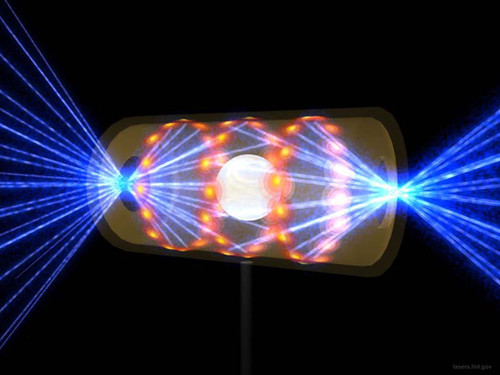The most energetic laser shot in mankind's history was fired at the stadium-sized National Ignition Facility in California this month. On March 15, an array of 192 lasers fired a shaped pulse of energy that generated 411 trillion watts of peak power - 1,000 times more than whole of the United States uses at any one moment.
The pulse is a historic moment for the 'fusion' facility, which aims to generate power using a
nuclear fusion reaction - similar to what happens in hydrogen bombs. The pulse only lasted for 23 billionths of a second. The laser array was not firing 'at' a target - but within two years, scientists will fire the 192 lasers at a 1mm pellet of hydrogen.
The NIF scientists hope that it will 'light the fuse' for a fusion reaction - the reaction that powers stars - which will release more energy than the lasers put in. 'Controlled' nuclear fusion - the reaction in a hydrogen bomb is uncontrolled - is a Holy Grail of clean energy that scientists have sought to crack since the Fifties. Because of the incredibly short duration of the pulse, the total amount of energy required is not as huge as it sounds, and is stored in huge battery-like capacitors at NIF. ‘This event marks a key milestone in the National Ignition Campaign's drive toward fusion ignition,’ said NIF Director Edward Moses.
‘While there have been many demonstrations of similar equivalent energy performance on individual beams or quads during the completion of the NIF project, this is the first time the full complement of 192 beams has operated at this sound barrier.’ Ignition would be a self-sustaining reaction that would release vast amounts of energy far surpassing the 'break even' point. The facility uses pellets of the hydrogen isotopes deuterium - found in 'heavy water' - and tritium, and fires lasers to compress the pellets to a few hundredths of its starting size.
The reaction fuses the atoms into helium atoms, and releases fast-moving subatomic particles called neutrons which can be used to heat water and drive steam turbines. Fusion is not, however, uncontroversial. The NIF is also associated with weapons programmes in the US - the process of fusion is also used in hydrogen bombs, and NIF works with America's Stockpile Stewardship and Management programme, designed to ensure its nuclear arsenal stays active. Environmental groups such as Greenpeace claim that research into fusion diverts funding from research into proven technologies such as wind and wave power.
The pulse is a historic moment for the 'fusion' facility, which aims to generate power using a
nuclear fusion reaction - similar to what happens in hydrogen bombs. The pulse only lasted for 23 billionths of a second. The laser array was not firing 'at' a target - but within two years, scientists will fire the 192 lasers at a 1mm pellet of hydrogen.
The NIF scientists hope that it will 'light the fuse' for a fusion reaction - the reaction that powers stars - which will release more energy than the lasers put in. 'Controlled' nuclear fusion - the reaction in a hydrogen bomb is uncontrolled - is a Holy Grail of clean energy that scientists have sought to crack since the Fifties. Because of the incredibly short duration of the pulse, the total amount of energy required is not as huge as it sounds, and is stored in huge battery-like capacitors at NIF. ‘This event marks a key milestone in the National Ignition Campaign's drive toward fusion ignition,’ said NIF Director Edward Moses.
‘While there have been many demonstrations of similar equivalent energy performance on individual beams or quads during the completion of the NIF project, this is the first time the full complement of 192 beams has operated at this sound barrier.’ Ignition would be a self-sustaining reaction that would release vast amounts of energy far surpassing the 'break even' point. The facility uses pellets of the hydrogen isotopes deuterium - found in 'heavy water' - and tritium, and fires lasers to compress the pellets to a few hundredths of its starting size.
The reaction fuses the atoms into helium atoms, and releases fast-moving subatomic particles called neutrons which can be used to heat water and drive steam turbines. Fusion is not, however, uncontroversial. The NIF is also associated with weapons programmes in the US - the process of fusion is also used in hydrogen bombs, and NIF works with America's Stockpile Stewardship and Management programme, designed to ensure its nuclear arsenal stays active. Environmental groups such as Greenpeace claim that research into fusion diverts funding from research into proven technologies such as wind and wave power.
written by Awais Ali












0 comments:
Post a Comment